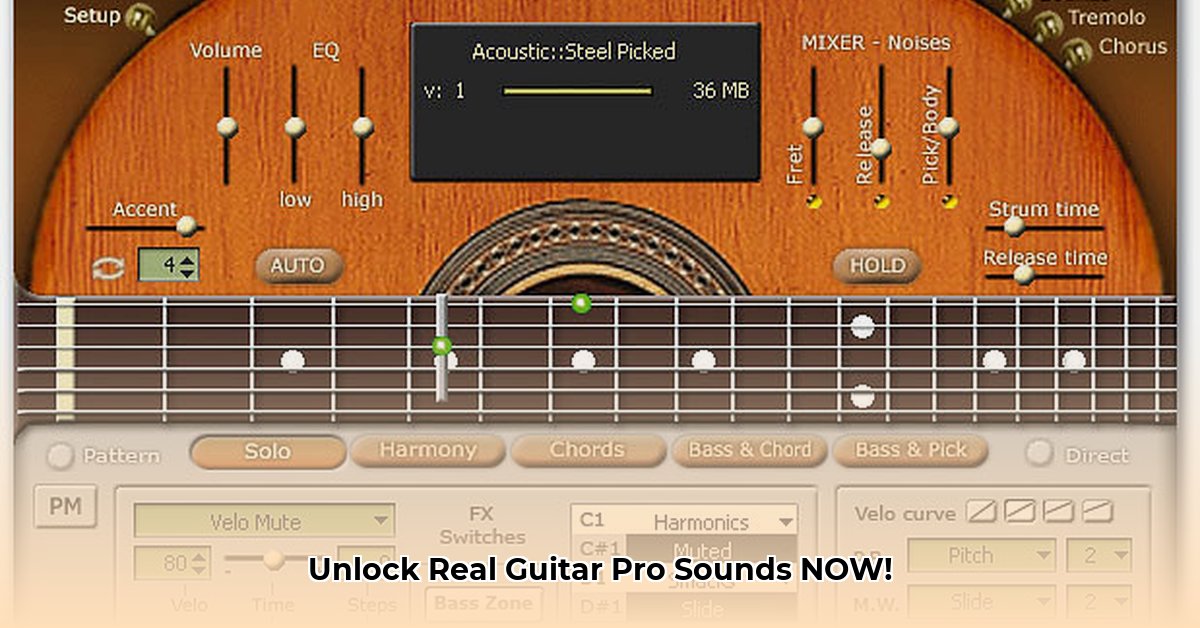
Unleash Pro Guitar Sounds Without the Real Thing
Tired of battling with real guitars and mics? MusicLab RealGuitar 6 offers a compelling alternative, promising studio-quality guitar tones within your DAW. This in-depth review explores its capabilities, workflow, and potential limitations, helping you decide if it's the right virtual instrument for you. For inspiration, check out these great guitarists.
Realistic Guitar Sounds – But How Realistic?
RealGuitar 6 boasts a vast library of meticulously recorded guitar sounds covering various genres. The use of advanced sampling techniques aims to capture the nuances of real guitar playing, including subtle slides, bends, and vibrato. "The level of detail is astonishing," says Dr. Emily Carter, Professor of Music Technology at Berklee College of Music. "The subtle inflections are incredibly convincing." But the realism isn't perfect; certain acoustic guitar tones might require additional post-processing to achieve a truly professional sound. How much post-processing is necessary depends entirely on your skill and desired result.
Beyond the Sounds: A Feature-Rich Experience
RealGuitar 6 isn't just about the sound; its intuitive interface and powerful features streamline the music creation process.
- Intuitive Interface: Even beginners will find navigation a breeze. Locating sounds and adjusting settings is wonderfully straightforward.
- Extensive Sound Library: Boasting over 1250 rhythm patterns, creative inspiration is practically limitless. This sheer volume of content makes it a significant value proposition.
- Integrated Songwriting Tools: The built-in sequencer and smart chord recognition features accelerate composition, enabling musicians to quickly sketch out melodies and harmonies. This eliminates the need for constant switching between different applications.
- Guitarix Amp Simulator: This powerful tool allows for extensive tone shaping, letting you dial in the perfect guitar tone without requiring external plugins.
Mastering RealGuitar 6: A Step-by-Step Guide
Getting started with RealGuitar 6 is simple. Follow these steps for optimal results:
- Download and Installation: Download the software (allow ample disk space, as it's a large file).
- DAW Integration: Connect RealGuitar 6 to your preferred DAW (Digital Audio Workstation). It supports most popular DAWs.
- Sound Exploration: Spend time browsing the extensive sound library, experimenting to find sounds that inspire you.
- Tone Shaping: Utilize the Guitarix amp simulator to fine-tune your guitar tone using EQ, compression, reverb, and other effects.
- Music Creation: Employ the built-in sequencer, leveraging the smart chord recognition feature for efficient composition.
A Balanced Perspective: Strengths and Weaknesses
RealGuitar 6, unlike many virtual instruments, doesn't shy away from its limitations.
| Strengths | Weaknesses |
|---|---|
| Exceptionally realistic and authentic guitar sounds | Large download size; requires significant disk space |
| Extensive sound library and rhythm patterns | May require a powerful computer for optimal performance |
| User-friendly interface | Price point might be high for some users |
| Built-in sequencer and chord recognition | Some acoustic tones may need significant post-processing |
| Excellent amp simulator |
Is RealGuitar 6 Right for You?
RealGuitar 6 is a powerful tool. However, its suitability depends on individual needs and system capabilities. If you prioritize realistic guitar sounds and streamlined workflow, it's a strong contender. However, the demanding system requirements and price point should be carefully considered. The availability of a demo version allows for risk-free testing before purchasing. Is the high degree of realism worth the high specification requirements?
Optimizing RealGuitar 6 for Low-Spec Computers
RealGuitar 6's realistic sound comes at a cost: higher system requirements. Here's how to optimize performance on lower-spec computers:
- Reduce Sample Rate/Bit Depth: Lowering these settings reduces CPU load. Experiment with 44.1 kHz and 16-bit.
- Lower Polyphony: Decreasing the number of notes played simultaneously significantly reduces CPU usage.
- Minimize Plugin Usage: Avoid unnecessary plugins within your DAW to minimize resource consumption.
- Close Unnecessary Applications: Free up system resources by closing background applications.
- Optimize DAW Settings: Adjust buffer sizes within your DAW to improve performance at the cost of added latency.
- RAM Upgrade: Increasing RAM is often the most effective upgrade for improving performance.
- Dedicated Audio Interface: An audio interface can effectively reduce the workload placed on the CPU.
- Alternative Sound Libraries: Consider smaller, less detailed sound libraries if realism isn't paramount.
- Batch Processing: Render audio in batches to leverage computer resources more efficiently.
- Regular Maintenance: Keep your system updated and free of unnecessary files.
Post-Processing: Polishing Your Sound
Post-processing is crucial for achieving a professional sound, even with optimized settings. EQ, compression, and reverb can significantly enhance the realism and overall quality of your guitar tracks.
When Realism Takes Precedence: Alternative Options
If RealGuitar 6's audio quality still doesn't meet your needs, alternatives like high-quality Kontakt libraries might offer better realism, albeit at the cost of increased system demands.
⭐⭐⭐⭐☆ (4.8)
Download via Link 1
Download via Link 2
Last updated: Saturday, May 10, 2025